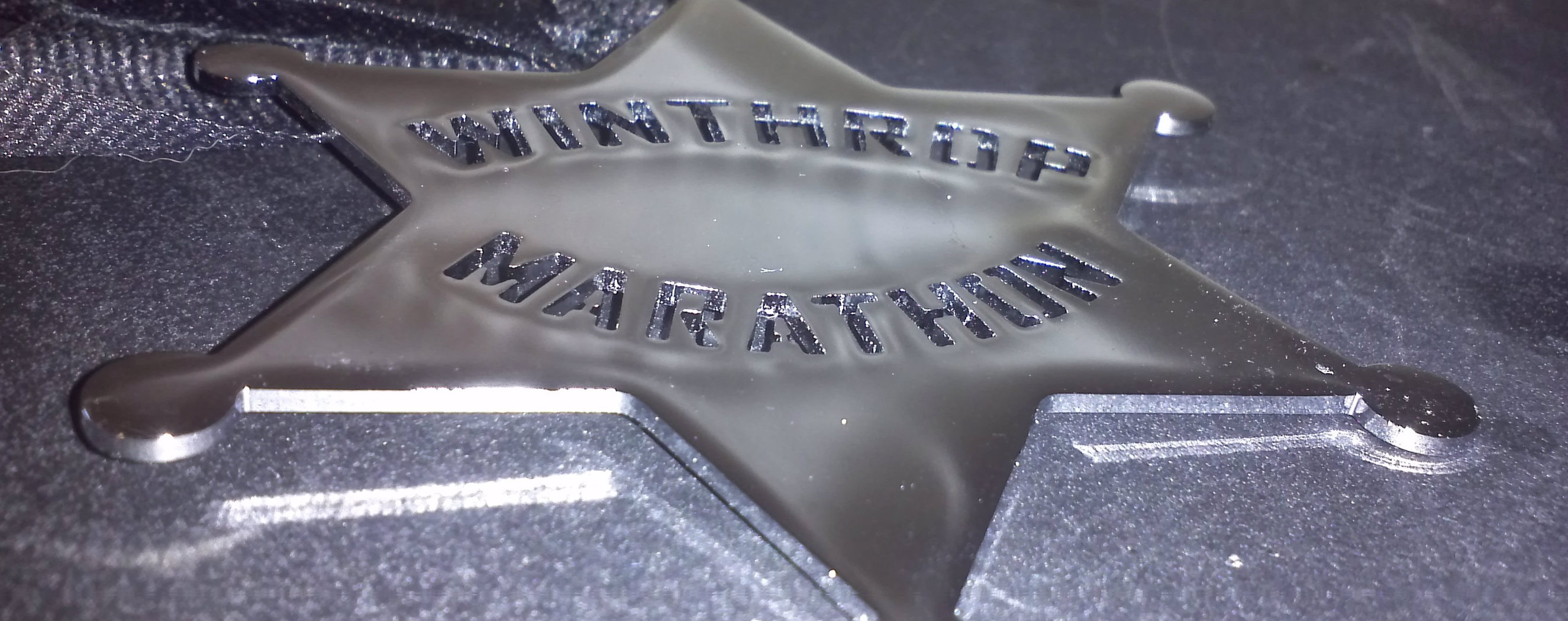50 Words for Snow by Mark Stone
June 2016. On my lunchtime runs along the Seattle waterfront I see them everywhere: the 'Bro Runners', broad shouldered and muscular, running shirtless side by side; the 'Cross Fit Queens', in their skin tight lycra, veins and muscles standing out as they struggle to carry their kettlebells up the Madison Street hill; mixed martial artists whipping through their sweat-filled workout as I pass through the gym on my way to the shower. These are the mascots for the "ethos of suffering". In their world pain is the adversary they eagerly battle, a foe to be embraced and dominated, because "no pain no gain" is our fitness way of life, right?
Then there is Juan. Sleek to the point of seeming frail, he runs the waterfront at lunch time also. I see him on the trail sometimes, and once in awhile we chat in the locker room. Juan is fast, but no brazen Bro Runner. He slips by you quietly, like a ghost, and in easy, loping strides he vanishes ahead, as if he was never there. I will never be as fast as Juan, though on my best days I can run as far. But watching him in the locker room strap on his heart rate monitor I know that Juan and I share a secret. We have both abdicated from the "ethos of sufering".
The indigenous people of the Arctic really do have 50 words for snow. They do not have 50 words because they love snow, nor because they hate it. Snow is an essential aspect of their environment, harnessed when possible, and shielded against when not. And so they must have a language of understanding to give meaning to their environment, and indeed to give meaning to themselves. When I finished my first marathon the only word I had was "suffering". I lacked my 50 words for pain.
Pain #1: That bit of hyper extension in the groin tendon. Give it some rest, then work on some lateral strength training to support it.
It's 7:00 AM, and we're on the bus from Port Angeles to the starting line of the North Olympic Discovery Marathon. I'm sitting next to Marie, a veteran marathon runner in her late 60s who is pacing today's race for the 5 hour 30 minute pace time. We chat about races we both have done, and we fret about the heat; it's already 70 degrees this morning. She inquires about my expectations, and I tell her I've been thinking about 5 hours to 5:15, but that's without factoring in the heat. We disembark at the starting line, and she flashes me a smile and says, "Well then, I hope I never see you again."
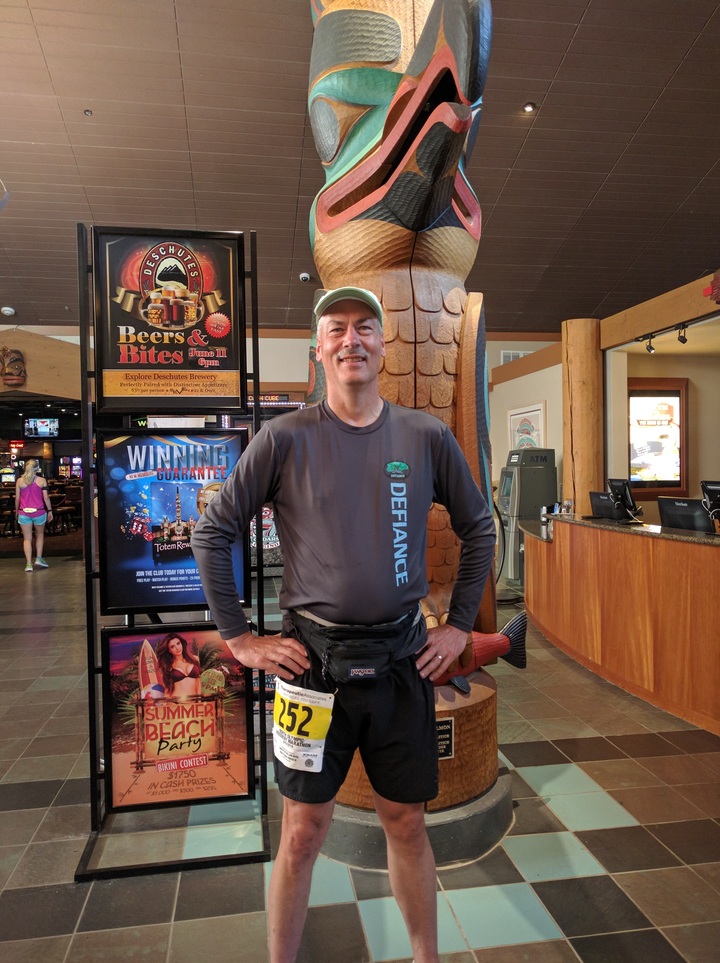
Here at the starting line there are no Bro Runners. Their domain is the 5k or 10k, or better yet a Tough Mudder or Spartan Run. But you cannot come to a marathon with an attitude that you will challenge pain. If you do, then pain will dominate you. I make my final preparations: finishing off a bottle of water, filling the two small bottles I'll carry on my fuel belt, applying vaseline in anticipation of a long, sweaty run, and spraying on sun screen for a course with little shade.
Pain #2: The tightness in the hamstring that needs further stretching, because the short hamstring is causing me to tug on the Achilles tendon. I need some better hamstring stretches to take some of the pressure off the Achilles.
The race director gathers us at the starting line and I dwell, as I often do at race starts, on motivation. Over the course of three previous marathon and two 50k attempts I have worked through all the standard runner motivations: "I just want to finish", "I want to go farther", "I want to go faster", "I want to finish under"... and sometimes, in each of these challenges I have set for myself, I have been denied. Yet if we do not ever fail, then we are not being ambitious enough. This is the lesson we learn as young children, testing the limits of our environment as an exercise in self discovery; trying to understand where we stop and the world outside us begins.
Pain #3: The prickly, tingling sensation at the back of my scalp. This is the early warning before heat exhaustion, and a clear signal to slow down and cool off.
My journey of self discovery with endurance running found direction after my first marathon, when realization came that "I do not ever want to suffer like this again" but also my mantra down the back stretch was "I do not want to suffer like this and not finish." As I look now at the runners jockeying at the starting line, I know there will be a lot of suffering in the heat today. How will I meet the challenge of suffering? To fight it is to lose. To ignore it is to lose. The beguiling path through the marathon is to understand pain, and through understanding it to manage it.
And just like that we are off. Across the highway, a hundred yards down a road, and we turn onto a quiet, shaded stretch of the Discovery Trail, a paved hiking and biking trail which will lead us from Discovery Bay all the way to Port Angeles.
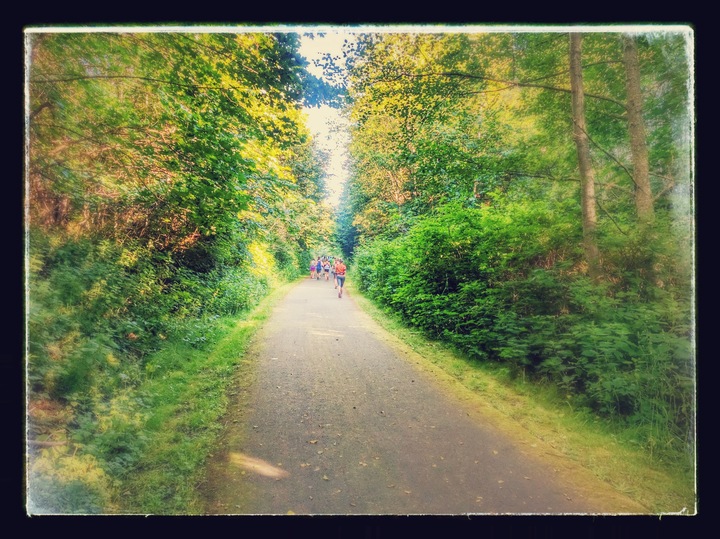
Pain #5: The dull ache in my right knee. This comes from running too fast on downhills that are too steep. They are a necessary part of training, but I cannot run them too often, or the dull pain will grow instead of subside.
For this race I've made some fundamental changes. I am not tracking my pace or time, and I'm doing my best to ignore the distance markers. My only measure will be level of effort, and my measure of effort will be the small heart rate monitor strapped to my fore arm and linked to my phone. My goal is to stay at or under 142 beats per minute (bpm).
In the opening couple of miles I listen to the 4:55 pace runner trash talking with her friends, but I soon leave them behind. In the back of my mind I know that heat and fatigue will bring me down from this pace, but for now I'm holding steady at a 138 bpm, and very happy to have the canopy of trees above us blocking the Sun.
Pain #8: The burning tightness along my IT band. There's a slight twisting motion I can put into some of my hamstring stretches that better engages this outer thigh area in the stretch, and I need to be more disciplined about incorporating that.
Somewhere around Mile 4 a flashing metallic purple skirt and a blur of pig tails goes flying by me. I'm surprised to catch up to her on the next uphill because I'm not much of a hill runner. I eye her gear appraisingly: fuel pack and fuel belt with holsters for two 8 oz water bottles. Normally I'd consider that overkill for a course with 14 aid stations, but for today she may be right. We chat for a bit. Her name is Monica, and she's from El Paso, where the flat expanse of West Texas doesn't afford her much hill training. I remark that at least she's well acclimated for today's heat. She quickly replies, "Oh no, not at all. This humidity is killing me." Even so, she has now caught her breath and soon leaves me behind.
Soon we come up to Mile 7, and the trail turns away from the coast -- and the trees. The flat, open farm land of the Sequim Valley lies before us for many miles. Now the real challenge begins.
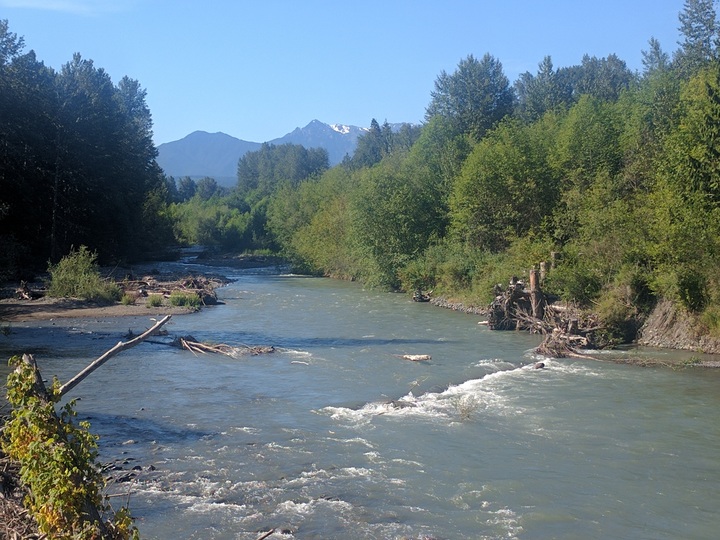
Pain #13: That sharp stab across the bottom of my foot. This is the plantar fascia, and I bought a special wedge-shaped piece of foam just for stretching it. If I still get pain, that's usually an indication that it's time for new shoes.
It's still early enough in the day that the heat and Sun are bearable. Still I'm grateful for my sunscreen, and also for the SPF hat that was a last minute purchase.
At one point I round a corner on the trail to see several runners bunched up and just standing around. I'm puzzled, until I realize that the sprinkler from the adjacent farm field just covers the trail at the top of its arc. We all enjoy a brief splash of relief and then carry on.
As the morning wears on, the heat builds. By Mile 13 we are nearing the end of the open valley, trees beckoning ahead. I'm stopping for water at every aid station, and Gatorade at most. I'm probably pouring as much water on me -- over my head, down the back of my shirt -- as I am in me. Anything to get that cooling evaporative effect working in my favor.
Pain #21: That slight queasiness is electrolyte imbalance. I need to find something salty in my snacks (or at the next aid station).
The heat is definitely slowing me down. Somewhere around Mile 14 the 4:55 pace runner catches up to me. We play leap frog for a mile or so, but my heart rate is telling me I have to ease up, and I lose her in the woods ahead. As she disappears I feel a moment of real satisfaction, if not happiness. I have at last found the humility to let my competitive beast go. I am running the race that the day and the heat dictate, rather than chasing some self imposed goal that has no relevance to the reality of the moment.
Around Mile 16 I catch up to an older runner. To me it's always inspiring to encounter people who are both older and faster than me. It gives me hope for the future. I tell him as much, and he laughs, and we chat a bit. His name is Bruce, he is 71, and this is his 152nd marathon. I tell him it's my fourth, and he says, "Ha! You're still a marathon virgin!"
In many ways he's right. Yet I know that the danger of today's conditions has pushed me to run with a restraint and mental balance I haven't experienced before. Perhaps I am losing that marathon virginity at last.
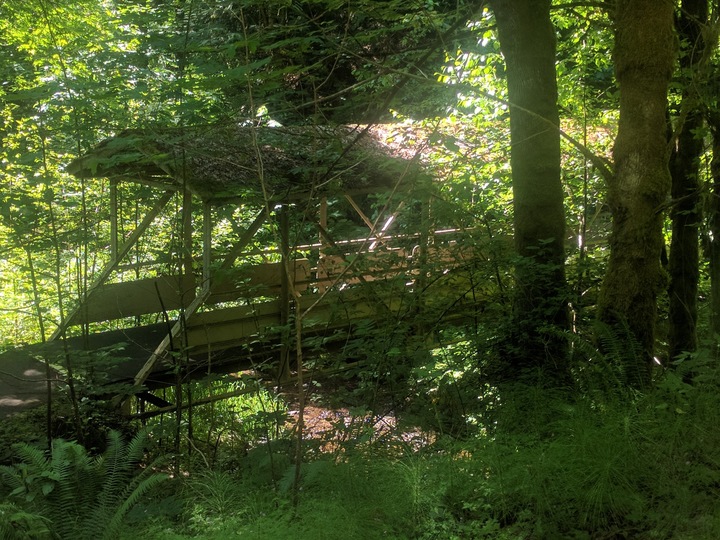
Pain #34: The grinding bight of my foam roller over soft tissue; a necessary pain to break down the tangled spagetti of scar tissue into something resembling the once smooth, straight muscle that resided here.
At Mile 17 I see a familiar flash of purple and pig tails up ahead. As I slow to her walking pace, I call out, "Hey El Paso! How're you doing?"
It takes Monica a moment to come out of her tunnel vision and recognize me. She attempts a smile that comes off as more of a grimace. "Not too good. This heat has really done me in."
"Well, just take it very easy. We have less than 10 miles to go at this point. We do 10 miles all the time, right?"
She glances at her Garmin and says, "Yeah, I think I can walk it in from here if I have to, and still make the cutoff time. Still doesn't hurt as much as child birth. I'm worried about my baby though."
Then she really stuns me. It turns out that she had just given birth three weeks ago. She had run steadily up until 6 days before giving birth, and has done one 14 mile run since -- her longest training run for this race. Baby and husband are waiting at the finish line. She pumped 20 oz of breast milk this morning, and 17 miles into this scorching race what she's worried about is that may not be enough to last until she makes it to the finish line.
It takes a moment for all this to sink in for me. I think about having 20 oz of fluid drained out of me right before race time on a day like today. With heightened urgency, I inquire, "Are you okay on water?"
Monica shrugs, and says, "My fuel pack is pretty much empty, but it's okay. I'll get water at the aid stations."
"No!" I say sharply. "You stop at the next aid station and get them to fill your fuel pack, okay?"
"Will they do that for me?"
Runners develop the strangest doubts when they're in the grip of a tough race. "Of course they will. You just take care of yourself, all right?"
She nods humbly, and I resume running, slowly leaving Monica behind.
Pain #39: The crescendo from dull ache to sharp pain with each stride of joints that are too many miles into concussive repetition. My evolving strategy to dampen this: tylenol and ibuprofen taken right before run time, as well as a concerted effort to stick to the gravel and dirt aside the trail whenver possible, rather than the asphalt of the trail itself.
The heat has become truly oppressive, and my heart rate is starting to climb beyond my ability to control. By Mile 18 I've elevated from the low 140s to about 150 bpm. Importantly this is still Zone 3 for me -- aerobic rather than anaerobic effort. But in the next couple of miles I shift up into the 152 - 155 bpm range, and even with increased walking breaks I can't get heart rate consistently below this.
Starting at the Mile 19 aid station they are giving out little zip lock bags filled with ice cubes. I take one, wrap it in a bandana, and put the bandana around my neck so that the ice rests right at the top of my spine. I don't think I've ever known such sweet relief.
This late in the race the runners are all spread out, and I run in long, solitary stretches with no one around. I am orchestrating a symphony of pain, and my muse is the ghost of Juan: quiet, steady, calm; one stride, then the next, then the next. Beat by beat I feel the pains of my body, but I neither fight them nor ignore them. I note them, respect them, and adjust: rounding this curve, get off the asphalt and onto the dirt; slow to walk on this rise; take the last of the water from my fuel belt and squirt it over my head; force myself to eat more of my trail mix; take both water and Gatorade at this aid station; refill my water bottles.
Pain #44: the slight twinge in the right abdomen of soft tissue being pressed through the abdominal wall. It's a hernia, but the doctor says I needn't worry as long as it's asymptomatic. I'm choosing to consider this twinge asymptomatic.
I top the rise of a long uphill, and see the rooftops of Port Angeles spread out before me. The trail makes a long, sweeping decent back towards the coast, the ocean breeze, and cooler temperatures. It dawns on me that I have endured, and I am going to finish. Not that I really had doubt, but I haven't given it much thought until this very moment.
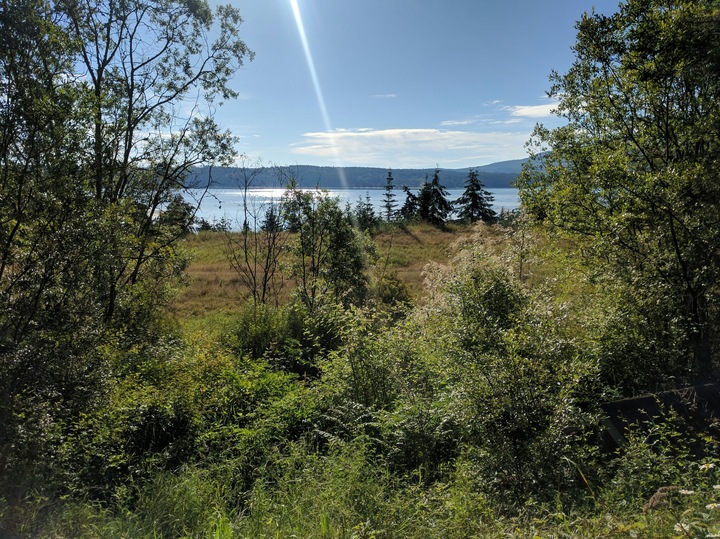
The home stretch is three miles of straightaway along the coast. I can see the Port Angeles pier, where the Finish Line waits, dangling in front of me like a mirage. The trees on my left provide shade, and the beach to my right provides a breeze and cooler temperatures. It's a little bit after noon. Over the course of the morning the heat has dragged me down from sub-10 minute miles to 12-13 minute miles. But I'm still moving steadily.
Pain #50: the deep ache where my hamstring anchors to the pelvis. This one will require a doctor's opinion, but not just yet. It subsides to a slight twinge whenever I run, and I have races dangling in front of me. After Baker Lake 50k in October, I'll get it tended to. I promise.
Somewhere after Mile 25 I realize that I'm just spent. My longest training runs were 22 miles, and in much milder temperatures. But it doesn't matter. With less than a mile to go, you just find a way. However successful your efforts at control, however well you've orchestrated your way through the race, the marathon is still a harsh mistress. At some point you will be stripped down to sheer will to get across the finish.
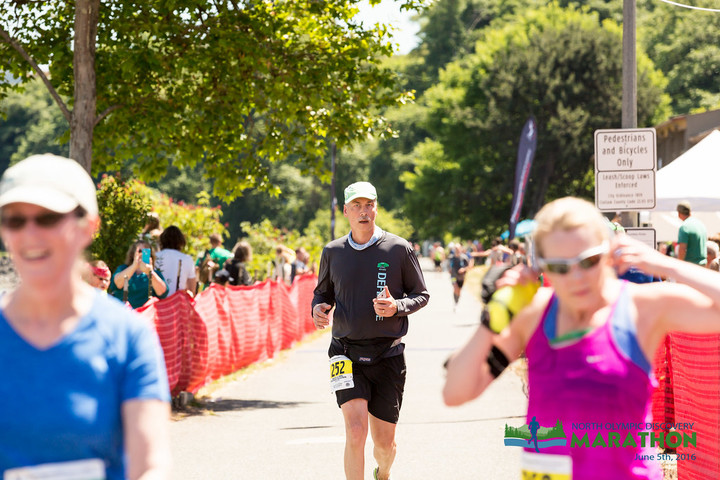
These thoughts vanish as the finish line comes into sight, and I see my wife and my son Nathan waiting. As I enter the finish chute Nathan reaches across the baracade and we high five. I'm all smiles as they call out my name crossing the finish line. I glance at the 5:21 time on the finish line clock, and silently I say, "Thank you Juan; you've been a good muse."
Like every previous marathon, now that its actually done, I feel shell shocked. All the fatigue my body has been supressing washes over me, and I can barely walk or speak. My wife has seen it all before, and gently guides me to where there is shade, water, and popsicles -- popsicles! -- awaiting. I love her more than ever for indulging my need to do this.
As the mental fog lifts, I realize I have landed in a different emotional place. Going forward, I will continue as I have begun this training cycle: focusing on level of effort, not pace, and carefully using heart rate to monitor and manage my effort. No longer will I be a disciple of the ethos of suffering.
We've lingered near the finish line for about half an hour, and now it's time to go. I'm holding Nathan's hand as my wife leads us back to the car. Just then I hear the finish line announcer call out, "Monica, from El Paso Texas!" That brings me to a stop, and my wife looks at me questioningly. "I'll tell you a story" I say, as we continue on. There's huge smile on my face that just won't go away.
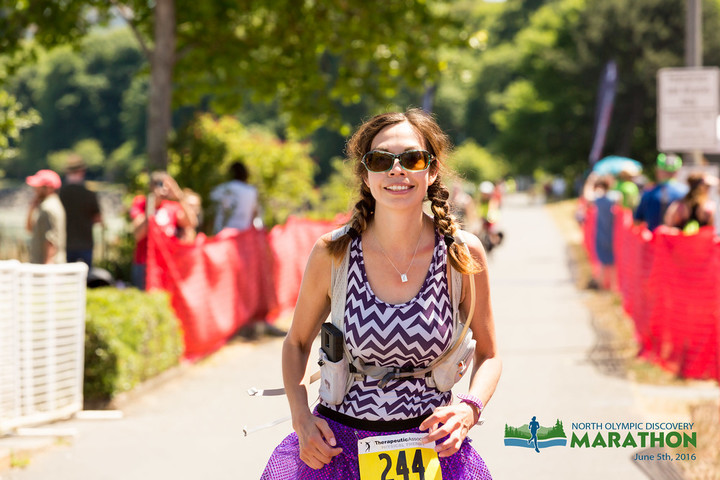
End Note: I owe a lot to this podcast featuring Brad Kearns for crystalizing my thinking about my marathon experience (and for introducing me to the phrase "ethos of suffering"). This spring has signified a major revision to my training approach, and through Brad's work and his book Primal Endurance I am finding kindred spirits out there.
